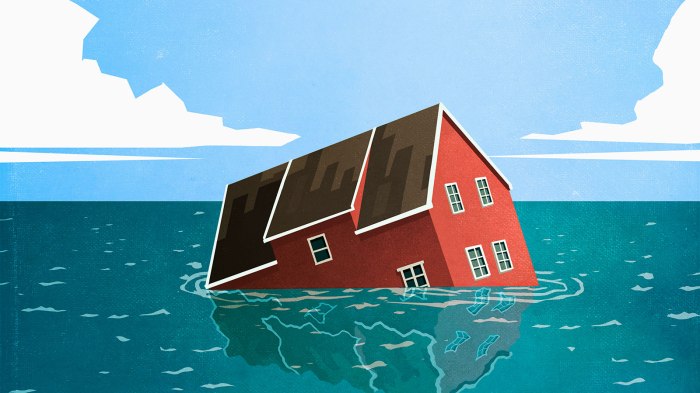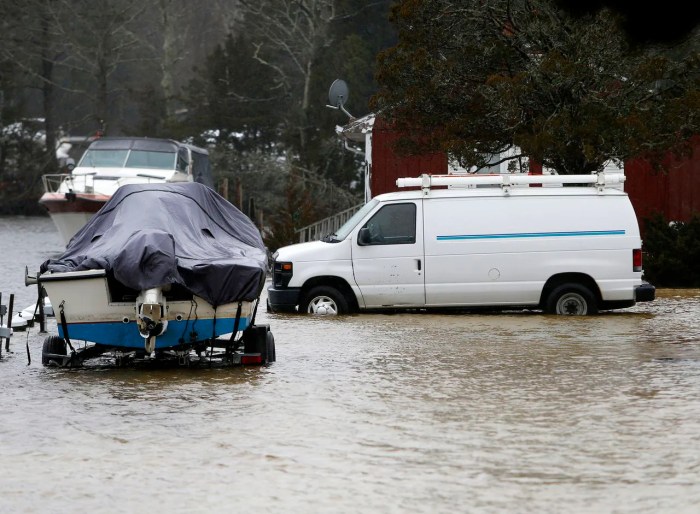The rising cost of flood insurance premiums is a growing concern for homeowners and businesses alike, particularly in areas prone to flooding. This comprehensive guide delves into the multifaceted factors influencing these premiums, offering insights into how location, building characteristics, and risk assessments play a crucial role in determining your insurance costs. We’ll explore the National Flood Insurance Program (NFIP), examine private insurance options, and discuss the significant impact of climate change on future premiums. By understanding these factors, you can better manage your flood insurance costs and protect your property.
Navigating the complexities of flood insurance can feel overwhelming, but this guide aims to simplify the process. We will provide clear explanations of key concepts, practical examples, and helpful comparisons to empower you with the knowledge needed to make informed decisions about your flood insurance coverage.
Understanding the National Flood Insurance Program (NFIP)

The National Flood Insurance Program (NFIP) is a federally-backed insurance program designed to mitigate the economic effects of flooding across the United States. It provides affordable flood insurance to homeowners, renters, and business owners in participating communities, helping to reduce the financial burden of flood damage and encouraging responsible land use practices. The program operates through a partnership between the federal government and participating insurance companies.
NFIP Structure and Purpose
The NFIP is administered by the Federal Emergency Management Agency (FEMA) and works by providing a framework for flood insurance coverage. Participating communities agree to adopt and enforce floodplain management ordinances, and in return, their residents become eligible for federally subsidized flood insurance. The purpose is twofold: to reduce the devastating financial consequences of floods on individuals and communities, and to encourage responsible land development practices that minimize future flood risks. Insurance companies sell the policies, and the NFIP reinsures a significant portion of the risk, thereby reducing the potential financial burden on individual insurers in the event of a widespread flood disaster.
NFIP Eligibility Requirements
To be eligible for NFIP coverage, a property must be located within a community that participates in the NFIP and be in a designated Special Flood Hazard Area (SFHA) as identified on FEMA’s flood maps. The property must also meet certain building code requirements, and the insurance application must be submitted before a flood occurs. There are specific waiting periods for new coverage to take effect, and certain types of properties, like those with repeated flood damage, might face stricter eligibility criteria or higher premiums.
Comparison of NFIP Policy Types
The NFIP offers two main types of policies: building coverage and contents coverage. Building coverage protects the structure of the building itself, while contents coverage protects the personal property inside. Both are available separately or together. The amount of coverage is determined by the property’s value and the risk of flooding in the area. Additionally, there are options for increased coverage limits beyond the standard amounts. The specific details of coverage and limits vary depending on the location and type of property.
Situations Where NFIP Coverage Might Be Insufficient
While the NFIP provides crucial flood protection, there are situations where its coverage might not be sufficient. For instance, the maximum coverage limits for both building and contents might not cover the full replacement cost of a severely damaged or destroyed property, especially in areas with high property values. Furthermore, the NFIP generally does not cover losses from the following: basement flooding (unless the basement is finished and above ground level), damage caused by sewer backup or other water sources not directly related to a flood event. Finally, the cost of mitigation measures, such as elevating a building or installing flood barriers, is typically not covered by the NFIP.
Comparison of NFIP Premiums versus Private Flood Insurance Premiums
The cost of flood insurance varies widely depending on several factors, including location, property value, and the level of risk. While the NFIP generally offers more affordable premiums, particularly in high-risk areas, private insurers may offer more comprehensive coverage options and higher coverage limits, albeit often at a higher cost.
| Factor | NFIP | Private Flood Insurance |
|---|---|---|
| Premium Cost | Generally lower, especially in high-risk areas. | Generally higher, but potentially more comprehensive coverage. |
| Coverage Limits | Set limits; may be insufficient for high-value properties. | Higher limits often available, but at a higher cost. |
| Coverage Options | Standard building and contents coverage. | More flexible and specialized coverage options often available. |
| Availability | Available in most participating communities. | Availability may be limited in some high-risk areas. |
Impact of Climate Change and Rising Sea Levels

Climate change is significantly altering flood risk, leading to substantial repercussions for the National Flood Insurance Program (NFIP) and individual policyholders. Rising sea levels, intensified storm surges, and more frequent extreme precipitation events are all contributing to increased flood frequency and severity, ultimately driving up insurance premiums. Understanding these impacts is crucial for effective risk management and future planning.
The projected effects of climate change on flood insurance premiums are substantial and multifaceted. Increased flood events, both in frequency and intensity, directly translate to higher payouts by insurance providers. This increased risk necessitates higher premiums to maintain the financial solvency of the NFIP and private insurers. Areas previously considered low-risk may become high-risk zones, requiring significant premium increases for residents. Conversely, areas already designated as high-risk may experience even steeper premium hikes as the likelihood and severity of flooding intensify.
Increased Frequency and Severity of Flooding Impacting Insurance Costs
More frequent and severe flooding events lead to a greater number of insurance claims, resulting in increased payouts by insurers. This increased financial burden is then passed on to policyholders through higher premiums. For example, a coastal community experiencing a major flood event every five years instead of every twenty years will see a dramatic rise in insurance costs as the insurer accounts for the heightened risk. The damage caused by more intense flooding events is also significantly greater, leading to substantially larger claim payouts. The cumulative effect of increased frequency and severity necessitates premium adjustments to ensure the financial stability of the insurance system.
Government Policies Addressing Rising Flood Risks and Premiums
Government policies play a crucial role in mitigating the impact of climate change on flood insurance. These policies can range from implementing stricter building codes in flood-prone areas to investing in infrastructure improvements designed to reduce flood risk. Furthermore, government initiatives promoting flood mitigation strategies, such as wetland restoration and improved drainage systems, can help reduce the frequency and severity of flooding, thus indirectly lowering insurance premiums in the long run. Subsidies or incentives for homeowners to implement flood-proofing measures can also be effective in reducing overall flood risk and claim costs. However, balancing affordability with the need to accurately reflect risk remains a significant challenge for policymakers.
Hypothetical Scenario Illustrating Long-Term Impact of Sea-Level Rise on Insurance Costs
A hypothetical coastal community, Seabrook, currently has an average flood insurance premium of $1,000 per year. Over the next 30 years, sea levels rise by one foot, increasing the frequency of minor flooding events from once every five years to once every two years, and the probability of major flooding events from once every twenty years to once every ten years. This increased risk would likely lead to a progressive increase in insurance premiums, potentially reaching $2,500 per year or more within the 30-year timeframe. The initial increase might be gradual, but the cumulative effect of increasingly frequent and severe flooding events would drive a substantial increase in the long term. This scenario illustrates how even a relatively modest sea-level rise can significantly impact insurance costs over time, forcing residents to adapt to substantially higher premiums or relocate.
Epilogue

Effectively managing flood insurance premiums requires a proactive approach to understanding risk and available options. From carefully considering your property’s location and characteristics to exploring mitigation measures and comparing NFIP and private insurance policies, informed decision-making is key. By understanding the factors influencing premiums and actively engaging with your insurance provider, you can mitigate costs and secure adequate protection against the devastating financial consequences of flooding. Staying informed about evolving flood risks and government policies will further enhance your ability to navigate this crucial aspect of property ownership.
FAQ Overview
What is the difference between the NFIP and private flood insurance?
The NFIP is a government program offering subsidized flood insurance, while private insurers offer market-based policies. NFIP often has stricter requirements and may not cover all flood risks, whereas private options can provide broader coverage but at potentially higher costs.
Can I lower my flood insurance premium?
Yes, several mitigation measures can reduce your premiums. These include elevating your building, installing flood barriers, and improving drainage around your property. Contact your insurer to inquire about available discounts.
How often are flood insurance premiums reviewed?
Premium reviews vary depending on your insurer and policy type. However, they are typically reviewed annually, and changes may reflect updated risk assessments or changes in your property.
What happens if I disagree with my flood zone designation?
You can appeal your flood zone designation by providing evidence to your insurer and FEMA that challenges the current assessment. This process often involves submitting detailed documentation and may require professional assistance.
What factors influence the cost of private flood insurance?
Private flood insurance premiums are determined by a variety of factors, including your property’s location, construction, value, and flood risk assessment. Your credit score and claims history may also influence your premium.